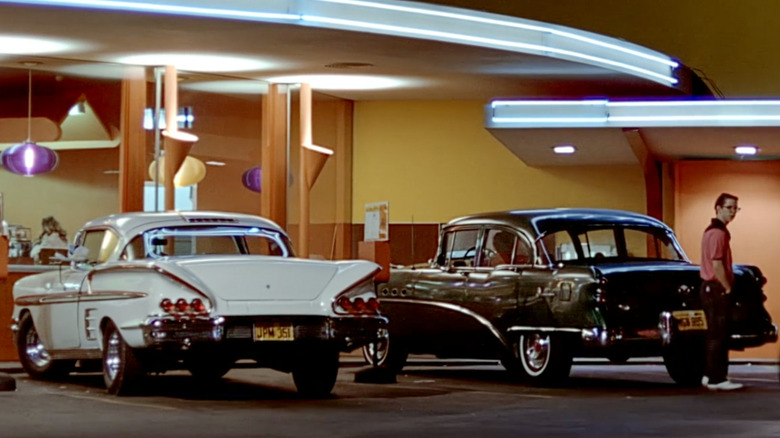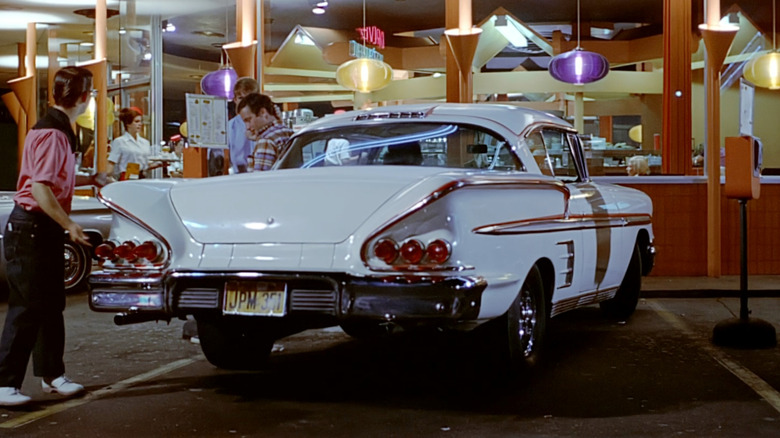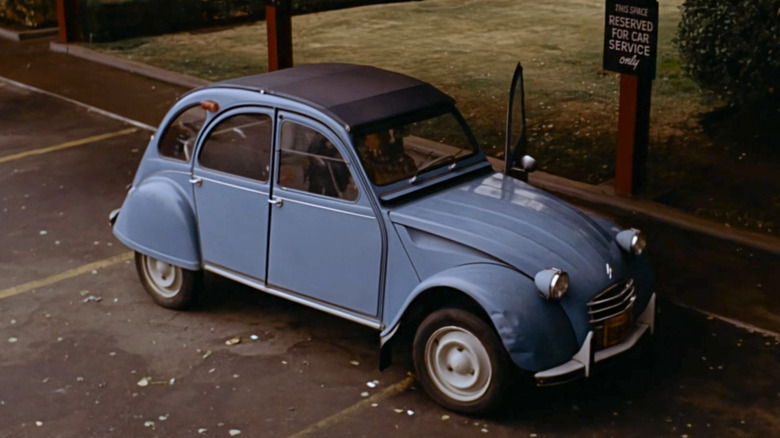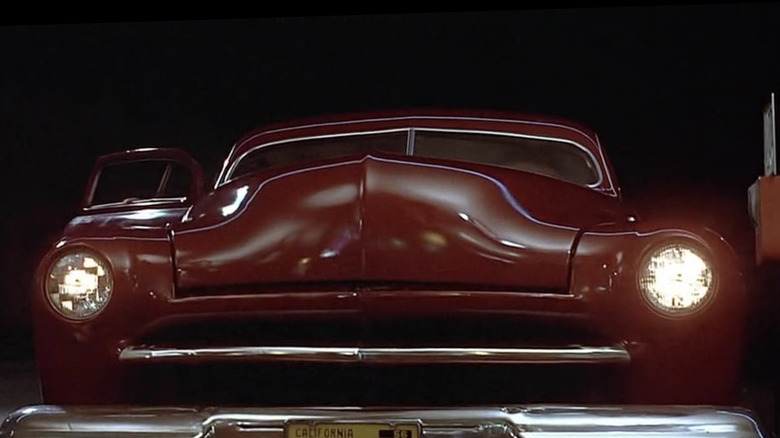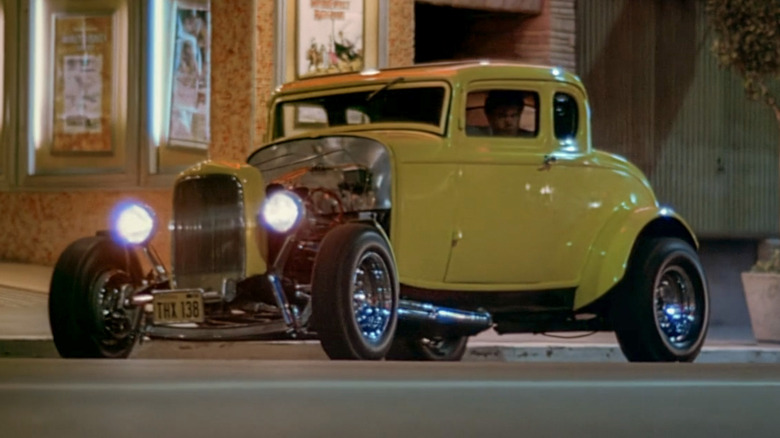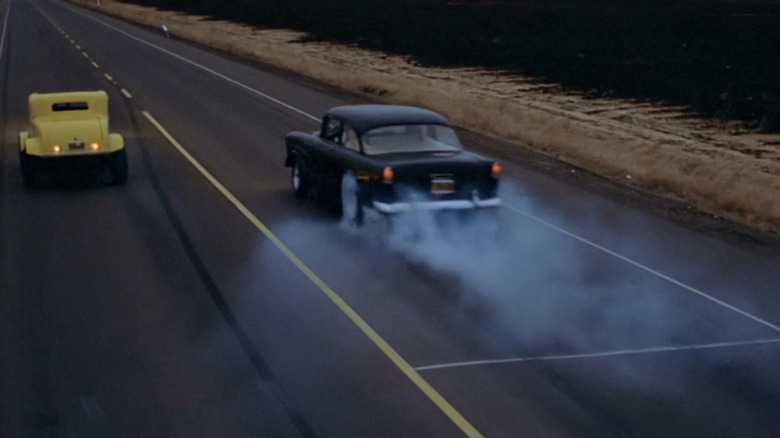5 Of The Coolest Cars From American Graffiti
We may receive a commission on purchases made from links.
American car culture has been featured in countless television shows and movies, from the mid-'60s TV comedy "My Mother the Car" to the much more recent "The Fast and the Furious" franchise, which has highlighted many impressive cars since the first film hit theaters in 2001. George Lucas is best known as the creative force behind the "Star Wars" film franchise, but he's also a noted gearhead who had dreams of becoming a race driver before a wreck turned his focus to filmmaking. Lucas blended the two interests — and paid tribute to his 1950s upbringing — with the 1973 coming-of-age flick "American Graffiti," which was Lucas' second feature film. "I spent four years of my life cruising the main street of my home town, Modesto, Calif," Lucas told the New York Times. I went through all that stuff, drove the cars, bought liquor, chased girls."
The lead roles in the film went to Ron Howard, Richard Dreyfuss, Paul LeMat, Cindy Williams, Mackenzie Phillips, and Harrison Ford, but the film's 1962 California setting also gave Lucas an excuse to feature some cars from the glorious 1950s and earlier. Here are a handful of our favorite "American Graffiti" cars and the stories behind them.
Ron Howard's character lends his 1958 Impala out to a friend
One of the most prominently featured cars in "American Graffiti" is the white 1958 Chevy Impala owned by Howard's character, Steve Bolander. Steve lends his car to his nerdy friend Terry Fields (Charles Martin Smith) for most of the film, who has it stolen from him while on a romantic adventure. Steve's car is festooned with chrome trim and red and gold paint, giving it a custom look that likely didn't come from the factory. 1958 was the first year for the Impala, which was sold as a variant of the Bel Air that year. It earned its own nameplate for 1959, and stayed in production over ten generations through the 2020 model year.
The film car had a 348-inch V8 with a four-barrel carburetor, and was sold to high school senior Mike Famalette for $285 after filming wrapped. The engine died while Mike was driving it home, so he and his brother swapped it out for a 283 cubic inch small-block. Mike joined the Marines in 1974 and left the car in his parents' garage, where it sat for decades. It went to auction in 2015, and NASCAR Hall of Famer Ray Evernham was able to strike a deal for the car. "When I was growing up, it was about that car," he told Car and Driver. Evernham painstakingly restored the Impala, down to the crocheted dice hanging from the rear-view mirror. "We wanted to put it back like people pictured in the movie," he explained.
Curt's Citroen 2CV was parked for most of the movie
Although most of the cars in "American Graffiti" are huge hunks of American-made steel and chrome, Dreyfuss' character Curt Henderson is the owner of a blue 1967 Citroen 2CV. Curt parks it outside Mel's Diner early in the film, and spends most of the night as a passenger in other people's cars. Lucas ignored the time-travel element of having a car from 1967 in a movie that took place in 1962, and the 2CV had stayed relatively unchanged since its debut in 1948. The French subcompact was similar to the Autobianchi Bianchina in which Lucas had his accident just a few days before his own 1962 high school graduation.
The Citroen from the film is now the property of Jerry Casubrook of Petaluma, California, where most of the movie was filmed. The town hosts an annual Cruisin' the Boulevard event to celebrate the film, and Causbrook is known to bring the Citroen and show it to fans. He bought the car from a woman in nearby St. Helena, and told the Santa Rosa Press Democrat, "It hadn't run in years and she was moving to L.A." Sal Maldonado's Sonoma County-born wife Jackie persuaded him to move to Petaluma after learning that's where "American Graffiti" was filmed, and the couple spoke to Press Democrat reporter Meg McConahey at last year's event. "This is the movie that got me into cars," Sal said. "I can't believe that this is the real car."
The Pharoahs drove a 1951 Merury Custom Coupe
Curt spends much of the night in a red 1951 Mercury Coupe driven by the Pharoahs, a local gang. Like many others from that era, the Pharoahs' Mercury is highly customized, with a low-rider suspension and chopped top. After the film was complete, the Mercury was parked on a lot at Universal Studios. Guitar legend Eddie Van Halen bought it from Universal and later sold it to Stray Cats frontman Brian Setzer. Hagerty reports that it eventually ended up in a salvage yard.
A similar crimson chop-top Mercury coupe appeared in animated form in the 2006 Pixar film "Cars," looking forlorn as it is hauled away by a tow truck. Red animated versions of the car have also appeared on "Beavis and Butthead" and "American Dad," and real-life Mercury Coupes from the era have appeared in more than 100 other Hollywood productions, including the 1954 version of "A Star is Born."
John Milner's Deuce Coupe is still on the road
The yellow hot rod driven by John Milner (Paul LeMat) gets probably more screen time than any other car in "American Graffiti," and is known around town as a formidable street racing machine. It's a 1932 Ford Deuce Coupe with the hood panels removed to show off its engine and front suspension, and has fat rear tires and prominent exhaust pipes to complete the look. The Beach Boys had memorialized the street racing legend on their 1963 album "Little Deuce Coupe," and the title track made SlashGear's list of the greatest car songs ever recorded. After filming, Steve Fitch of Kansas City bought the hot rod, along with the next car on this list.
Rick Figari of San Francisco picked up the Deuce Coupe in 1985, and decades later is still impressed by the film's staying power. He told Hagerty he was driving the car on the highway in California when another' car's occupants recognized the Coupe. "They wound down the windows and shouted 'Hey is that the real car from 'American Graffiti?'" Figari recounted. "They were only about 20 years old — they weren't even born when the film was made and I realized it had jumped generations." When he bought the car, its piston gear shift knob and "THX 138" license plate were in the trunk, lending some authenticity to his purchase.
Bob Falfa's 1955 Chevy lost the film's big race
Milner's Deuce takes on a black 1955 Chevy 150 driven by brash out-of-towner Bob Falfa (Harrison Ford) in the film's climactic scene. Falfa drives his car off the road into a ditch where it flips over, catches fire, and explodes. He and Curt's sister Laurie (Cindy Williams) escape without serious injuries, but Falfa's ego is as destroyed as his car.
Universal enlisted Hollywood automotive legend George Barris to acquire the Chevy, along with Milner's Deuce Coupe and other cars used in the film. Barris was also responsible for crafting the original Batmobile and several other iconic film and television cars.
Steve Figari also came to own one of the two Chevys used for the cruising scenes in the film. Another that had been rescued from a salvage yard was used in the crash sequence. It was the last scene filmed for the movie, and two attempts were made before the car flipped onto its roof as Lucas intended. Frates Road on the eastern edge of Petaluma served as the stand-in for Paradise Road, where the nearly tragic race took place.
